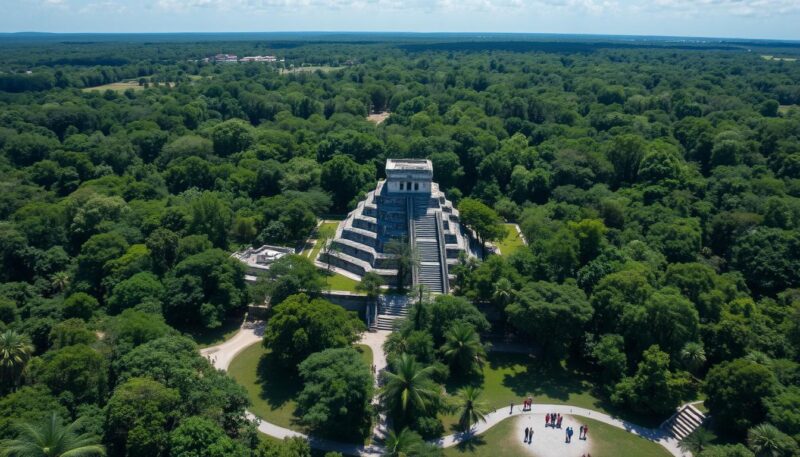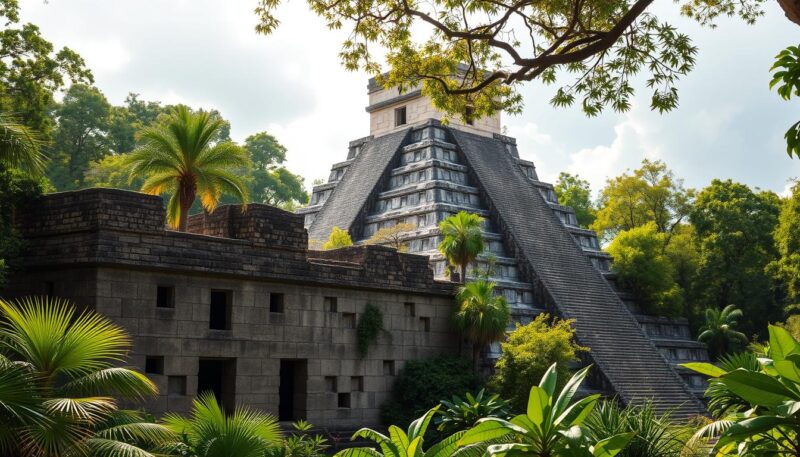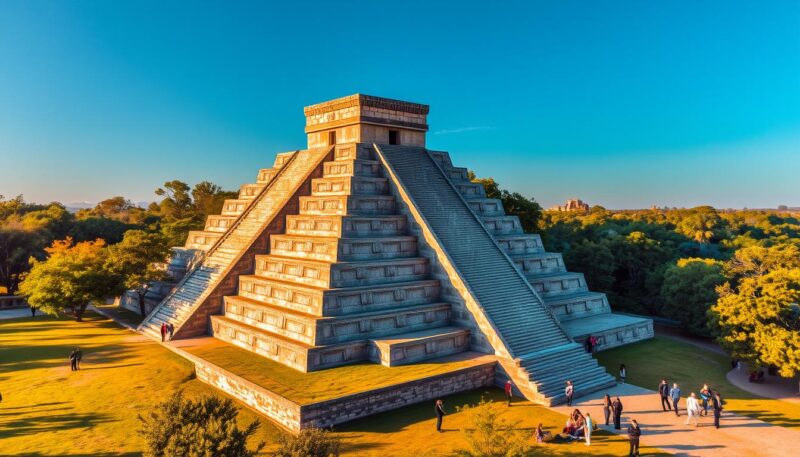Chichen Itza, a UNESCO World Heritage Site, beckons travelers from around the globe to experience the remnants of the mighty ancient Maya civilization. Located in the Yucatan Peninsula, this incredible archaeological site stands out for its fascinating history and the breathtaking architecture of ancient Maya structures. With its iconic El Castillo, a pyramid that commands attention with its impressive height of 30 meters (100 feet), Chichen Itza draws millions of visitors each year. This guide will unravel whether you can go inside Chichen Itza, along with crucial Chichen Itza rules, and offer visiting Chichen Itza tips to help make the most of your trip.
When exploring Chichen Itza, understanding its long history provides context that enhances your visit. Inhabited from around AD 750 to AD 1200, this site flourished during its peak. Boasting fascinating features, including the Great Ball Court—larger than an American football field—Chichen Itza serves as a time capsule of ancient Maya culture. As you navigate through the remnants of this vibrant civilization, you will encounter hidden gems, learn about the significance of cenotes in Mayan life, and appreciate the astronomical prowess demonstrated by the El Caracol Observatory.
Equipped with useful Yucatan travel advice, enthusiasts will gain insights into what to expect while visiting Chichen Itza. From essential information regarding admission fees to understanding the importance of arriving early to avoid crowds, this guide offers everything needed for an unforgettable journey. Weave these elements together to create a rich experience steeped in the legacy of the ancient Maya, ensuring your feet tread the path of history with care and respect.
Exploring Chichen Itza: A Brief Overview
The history of Chichen Itza offers a fascinating glimpse into the ancient Maya civilization. Founded between the 9th and 12th centuries, this remarkable site thrived as a cultural and commercial hub with a peak population of about 35,000. The city is a treasure trove of ancient Maya structures, showcasing sophisticated engineering and cosmological symbolism, particularly evident in the iconic Pyramid of Kukulcan, known as El Castillo.
History of Chichen Itza
Chichen Itza’s story begins in 550 CE, evolving into a significant center for trade and religion. The site saw intense construction during the Early Post-Classic Period, reflecting its importance in Mexico archaeology. Scholars believe it faced a decline between AD 1000 and the 1400s, leading to its eventual abandonment by the 16th century. Today, it stands recognized as a UNESCO World Heritage site since 1988.
What You Can See Inside the Site
What’s inside Chichen Itza is both mesmerizing and extensive. Visitors can explore the magnificent structures scattered across approximately six square miles. The Sacred Cenote, a significant pilgrimage site, and the Great Ball Court, the largest of its kind in the Americas, are must-see attractions. The ball court measures over 545 feet in length and offers insights into the ancient ball game, Pok Ta Pok, once played by the Maya.
Major Structures: El Castillo and More
The Pyramid of Kukulcan is undoubtedly the focal point of Chichen Itza. Rising approximately 79 feet above the Main Plaza, El Castillo features 365 steps—one for each day of the year—and showcases Kukulkan pyramid facts that captivate all who visit. The structure has four sides, each adorned with 91 steps leading to a top platform. Other noteworthy sites include the Tzompantli, the Temple of the Warriors, and El Caracol, the Observatory, which align with celestial events and reveal the sophisticated astronomical knowledge of the ancient Maya.
| Structure | Details |
|---|---|
| Pyramid of Kukulcan (El Castillo) | Height: 79 feet, 365 steps, 4 sides with 91 steps each |
| Great Ball Court | Length: 545 feet, Width: 223 feet, largest in the Americas |
| Sacred Cenote | Diameter: 60 meters, Depth: 30 meters, significant for offerings |
| El Caracol (The Observatory) | Astronomical alignments with celestial events |
| Tzompantli (Skulls Platform) | Length: 60 meters, Width: 12 meters |
Can You Go Inside Chichen Itza? Access and Rules
Understanding access rules and regulations is essential for a rewarding visit to Chichen Itza. This remarkable site not only offers a glimpse into ancient Mayan civilization but also has specific admission guidelines and fees that every visitor should be aware of.
Admission Guidelines and Fees
Can you enter Chichen Itza? The answer is yes, but entry involves a fee structure designed for both international travelers and Mexican citizens. As of March 2021, the standard cost for non-citizens is approximately 533 MXN, roughly $26. For Mexican citizens, the fee consists of 157 Pesos plus an additional entry cost of 80 Pesos on non-Sundays. A daily limit of 3,000 visitors ensures a pleasant experience, and the site opens at 8 a.m.—arriving early is advisable to minimize waiting times as tour buses typically arrive around 10 a.m.
Dress Code and Visitor Conduct
Visitors should adhere to a respectful dress code that reflects the cultural significance of Chichen Itza. Comfortable attire is suitable due to the extensive walking involved. However, overly casual clothing, such as swimsuits, is discouraged. Maintaining respectful behavior is important, as the site is both a historical treasure and a UNESCO World Heritage Site.
Climbing and Restricted Areas
Since 2006, climbing Chichen Itza, particularly on the iconic El Castillo, has been prohibited to maintain the structure’s integrity. Additionally, certain restricted areas Chichen Itza are off-limits to protect their historical significance and ensure their preservation for future generations. Visitors should familiarize themselves with these regulations to enhance their overall experience while contributing to the site’s conservation.

Chichen Itza Secrets and Hidden Gems
Chichen Itza captivates visitors not only with stunning architecture but also with a tapestry of secrets and lesser-known facts that enhance the experience of this ancient wonder. Uncovering these hidden gems Chichen Itza provides insights that deepen the appreciation for its rich cultural heritage.
Uncovering Lesser-Known Facts
Many tourists focus on the grand structures like El Castillo, yet there are numerous Chichen Itza secrets waiting to be discovered. The ancient city served as a crucial center for trade, astronomy, and rituals, weaving a complex narrative that extends beyond its well-known pyramids. Visitors can explore the expansive layout that encompasses not just temples, but also ball courts and platforms that played critical roles in Maya society.
The Role of Cenotes in Mayan Culture
One cannot discuss Chichen Itza without acknowledging the importance of cenotes in Mayan culture. The Sacred Cenote, located near the site, was more than just a water source; it was integral to rituals and offerings, often believed to be gateways to the underworld. These natural wonders were vital to sustaining the civilization, guiding both daily life and ceremonial practices.
The Importance of El Caracol Observatory
El Caracol signifies the Maya’s profound understanding of astronomy. This observatory, with its unique circular design, served as a crucial point for tracking celestial events. Its alignment with astronomical phenomena allowed the Maya to develop agricultural cycles, demonstrating their skill in harmonizing natural rhythms with daily life. The significance of El Caracol extends beyond mere observation; it embodies the intricate relationship between the cosmos and Mayan civilization.

Conclusion
Visiting Chichen Itza is more than just a trip; it is an immersive experience into one of the most significant ancient Maya structures. Situated approximately 120 miles from Cancun, this UNESCO World Heritage Site offers insights into the remarkable civilization that flourished here from the early 400s A.D. As you navigate through nearly two square miles of temples, pyramids, and ceremonial spaces, you’ll discover the extraordinary historical and cultural context that makes this site a must-see.
By being aware of Chichen Itza rules, including access regulations and visitor conduct, travelers can ensure a smooth visit. Whether it’s marveling at the 365 steps of El Castillo during the spring equinox or exploring the depths of the Sacred Cenote, there are numerous opportunities to engage with the rich legacy of the Mayan civilization. Following visiting Chichen Itza tips—like joining a guided tour for comprehensive insight—essentially enhances your journey and fosters a deeper appreciation for this ancient wonder.
In conclusion, for anyone seeking Yucatan travel advice, Chichen Itza stands as a testament to human achievement and architectural brilliance. As one of the world’s New 7 Wonders, the site not only represents the past but continues to captivate around 2 million visitors yearly, offering the chance to walk among history. Ensure you explore this marvel thoughtfully to truly grasp its significance and the stories it holds within its confines.

